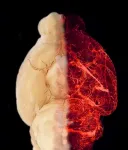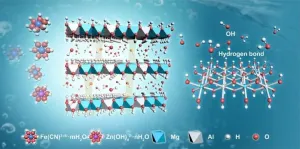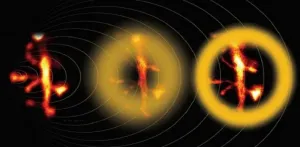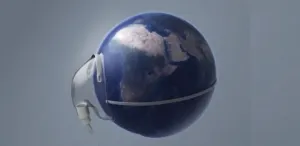From symmetry to asymmetry: The two sides of life
Researchers at Osaka University use innovative imaging techniques to dynamically demonstrate that symmetric, collective alignment of cell nuclei influences left-right asymmetric development in the midgut of the fruit fly embryo
2021-06-15
(Press-News.org) Osaka, Japan - On the outside, animals often appear bilaterally symmetrical with mirror-image left and right features. However, this balance is not always reflected internally, as several organs such as the lungs and intestines are left-right (LR) asymmetrical. Researchers at Osaka University, using an innovative technique for imaging movement of cell nuclei in living tissue, have determined the patterns of nuclear alignment responsible for LR-asymmetrical shaping of internal organs in the developing embryo.
Embryogenesis involves complex genetic and molecular processes that transform a single-celled zygote into a complete, living individual with multiple functional axes, including the LR axis. A long-standing conundrum of Developmental Biology is the breaking of LR symmetry in the developing embryo to initiate lateralization (dominance of one side over the other) of organs and other structures of the body along the LR axis. Mechanisms that induce LR asymmetry are well known in vertebrates; however, the biomechanics in invertebrates remain uncertain.
The research team focused on the development of the intestine, in particular the anterior midgut (AMG) of the Drosophila (fruit fly) as an appropriate model to study LR-asymmetric development in invertebrates. "Proper organ development often requires nuclei to move to a specific position within the cell," first author Dongsun Shin explains. "Our previous studies had revealed the molecular signaling pathways as well as the proteins responsible for the biomechanical control of asymmetric development, but the dynamics had not yet been determined."
To meet the challenge of dynamically tracking nuclei in living tissue, the researchers innovated a new method to investigate nuclear migration. Using a confocal laser scanning microscope, they obtained three-dimensional (3D) time lapse videos of immunostained Drosophila midgut at the appropriate embryonal stage. Then, applying mathematical modeling and computational imaging techniques they generated 3D-surface animated models of nuclear migration in the visceral muscles.
Through 3-D time-lapse movies, the researchers identified the initial LR-symmetrical distribution of AMG muscle nuclei along the antero-posterior (front-to-back) axis--termed 'proper nuclear positioning.' Further, they vividly imaged 'collective nuclear behavior' in which crowded nuclei actively rearranged their relative positions with LR symmetry. This symmetric initial 'proper nuclear positioning' and 'collective nuclear behavior' are responsible for subsequent LR-asymmetric development of the AMG. In contrast, experiments in genetically modified Drosophila embryos demonstrated that when the nuclei aligned with LR-asymmetry, the subsequent LR-asymmetric development of the AMG was lost. It is known that nuclei are the toughest intracellular organelles. Thus, based on these results, the researchers speculated that nuclei may act like structural pillars if they are collectively aligned, which support the structure of the gut and influence LR-asymmetrical changes in shape during its development.
Senior author Kenji Matsuno explains the potential of their findings: "This new method of tracking moving nuclei in vital tissue has helped clarify the role of nuclear alignment in asymmetrical shaping of internal organs during normal development. In addition, our findings are expected to be applied to controlling the shape of regenerative organs. This knowledge could potentially shape future research into organ regeneration which may have applications such as growing artificial organs to model disease mechanisms."
INFORMATION:
The article, "Collective nuclear behavior shapes bilateral nuclear symmetry for subsequent left-right asymmetric morphogenesis in Drosophila" was published in Development at DOI: https://doi.org/10.1242/dev.198507
About Osaka University
Osaka University was founded in 1931 as one of the seven imperial universities of Japan and is now one of Japan's leading comprehensive universities with a broad disciplinary spectrum. This strength is coupled with a singular drive for innovation that extends throughout the scientific process, from fundamental research to the creation of applied technology with positive economic impacts. Its commitment to innovation has been recognized in Japan and around the world, being named Japan's most innovative university in 2015 (Reuters 2015 Top 100) and one of the most innovative institutions in the world in 2017 (Innovative Universities and the Nature Index Innovation 2017). Now, Osaka University is leveraging its role as a Designated National University Corporation selected by the Ministry of Education, Culture, Sports, Science and Technology to contribute to innovation for human welfare, sustainable development of society, and social transformation.
Website: https://resou.osaka-u.ac.jp/en
[Attachments] See images for this press release:
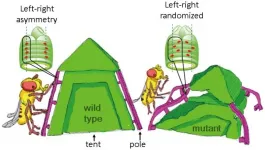
ELSE PRESS RELEASES FROM THIS DATE:
2021-06-15
Researchers at the University of Helsinki and the Beatson Institute for Cancer Research in Glasgow have discovered how mutated cells promote their chances to form cancer. Typically, the accumulation of harmful cells is prevented by active competition between multiple stem cells in intestinal glands, called crypts.
"The functioning of intestinal stem cells relies on growth factors, named Wnts, produced by the surrounding environment. Intestinal cancers typically originate from stem cells where mutations allow growth independent of these factors. When we removed a gene called Notum, which renders Wnts inactive, from mutated stem cells, the number of precancerous adenomas in the intestine was greatly reduced. We found that ...
2021-06-15
Echoing through history by reviving fungal specimens originally preserved and described a flabbergasting quarter of a millenium ago by the "Father of Modern Taxonomy" Carl Linnaeus, this study highlights the untapped potential of museum collections in modern research programmes. The results have just been published in the renowned Cell Press journal iScience.
The "desert coprinus" fungus Podaxis has fascinated scientists and explorers for centuries, still the genus has been subjected to relatively little research. These large mushrooms thrive in hostile and mostly species-free environments and while they occur seasonally ...
2021-06-15
Hypertension is a widespread comorbidity of patients with obesity that greatly increases the risk of mortality and disability. In recent years, researchers have found that a high-calorie diet increases the density of blood vessels (hypervascularization) in the hypothalamus - an important "eating control" area in our brain. Researchers hypothesized that elevated hormone levels of leptin are associated with a higher risk of developing hypertension. However, the exact mechanisms that contribute to the condensed growth of blood vessels in the hypothalamus were unknown.
New research conducted by Cristina García-Cáceres' research group at Helmholtz Zentrum ...
2021-06-15
Solar activities, such as CME(Coronal Mass Ejection), cause geomagnetic storm that is a temporary disturbance of the Earth's magnetosphere. Geomagnetic storms can affect GPS positioning, radio communication, and power transmission system. Solar explosions also emit radiation, which can affect satellite failures, radiation exposure to aircraft crew, and space activity. Therefore, it is important to understand space weather phenomena and their impact on the Earth.
Space weather research by continuous observation of cosmic rays on the ground is mainly conducted using observation data from neutron monitors and multi-directional muon detectors. Since the phenomenon of space weather is on a short-term, days-long scale, it is effective to investigate changes in the flow ...
2021-06-15
Alkaline zinc-iron flow battery (AZIFB) is well suitable for stationary energy storage applications due to its advantages of high open-cell voltage, low cost, and environmental friendliness. However, it surfers from zinc dendrite/accumulation and relatively low operation current density.
Recently, a research group led by Prof. LI Xianfeng from the Dalian Institute of Chemical Physics (DICP) of the Chinese Academy of Science (CAS) developed layered double hydroxide (LDH) membrane with high hydroxide conductivity and ion selectivity for alkaline-zinc iron flow battery.
The ...
2021-06-15
Light--and all waves--can bend around the corners of obstacles found along its path. Because of this phenomenon, called diffraction, it is impossible to focus light onto a spot that is smaller than half its wavelength. In other words, the highest resolution one can theoretically achieve using an optical microscope is approximately 250 nm, a barrier called the diffraction limit. Unfortunately, this resolution is not enough for observing fine cellular structures, such as those found in neurons.
Over more than a century, microscopists were hamstrung by this classic barrier until the invention of super-resolution fluorescence microscopy. One particularly powerful ...
2021-06-15
Researchers have identified two subgroups of adolescents who self-harm and have shown that it is possible to predict those individuals at greatest risk almost a decade before they begin self-harming.
The team, based at the MRC Cognition and Brain Sciences Unit, University of Cambridge, found that while sleep problems and low self-esteem were common risk factors, there were two distinct profiles of young people who self-harm - one with emotional and behavioural difficulties and a second group without those difficulties, but with different risk factors.
Between one in five and one in seven adolescents in England self-harms, for example by deliberately cutting themselves. While self-harm is a significant risk factor for subsequent suicide attempts, many do not intend suicide but face ...
2021-06-15
A new study by Newcastle University shows that the risk of dolphins and porpoises being caught in small-scale (artisanal) fisheries is highest in low- and middle-income regions around the tropics and sub-tropics.
Marine scientists assessed the risk posed by small-scale fisheries to all 72 species of toothed whales found throughout the world's oceans. They found that this risk was highest in the Central Indo-Pacific, Temperate Northern Pacific, Temperate South America and the Western Indo-Pacific.
Publishing their findings in the journal Fish and Fisheries, the authors ...
2021-06-15
Stem cell biologist Hugo Vankelecom (KU Leuven) and his colleagues have discovered that the pituitary gland in mice ages as the result of an age-related form of chronic inflammation. It may be possible to slow down this process or even partially repair it. The researchers have published their findings in PNAS.
The pituitary gland is a small, globular gland located underneath the brain that plays a major role in the hormonal system, explains Professor Hugo Vankelecom from the Department of Development and Regeneration at KU Leuven. "My research group discovered that the pituitary gland ages as a result of a form of chronic inflammation that affects tissue and even the organism as a whole. This natural process usually goes unnoticed ...
2021-06-15
The inclusion of biological uncertainty and the latest case data can significantly improve the prediction accuracy of standard epidemiological models of virus transmission, new research led by KAUST and the Kuwait College of Science and Technology (KCST) has shown.
Modern mathematical epidemic models have been tested like never before during the COVID-19 pandemic. These models use mathematics to describe the various biological and transmission processes involved in an epidemic. However, when such factors are highly uncertain, such as during the emergence of a new virus like COVID-19, the predictions ...
LAST 30 PRESS RELEASES:
[Press-News.org] From symmetry to asymmetry: The two sides of life
Researchers at Osaka University use innovative imaging techniques to dynamically demonstrate that symmetric, collective alignment of cell nuclei influences left-right asymmetric development in the midgut of the fruit fly embryo

